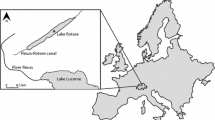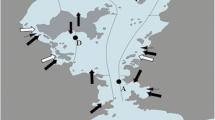Abstract
Translocation of 14C-labelled assimilates in Laminaria hyperborea and L. saccharina is strictly basipetal within the thallus. The lowermost 20 cm of the frond accumulates 71% (L. hyperborea) or 63% (L. saccharina) of the basipetallymoving translocate after a period of 96 h from initial feeding with NaH14CO3. Whereas translocation was found to occur at all seasons in L. saccharina, which grows throughout the year, no translocation of newly synthesized photosynthate occurred in L. hyperborea in October, when no frond enlargement takes place, nor in January, when the new fond occurs as a tiny outgrowth. In L. hyperborea, organic material, assimilated by the old frond during the period of rapid growth, is exported at the rate of 0.5 mg C · dm-2 · h-1. In L. saccharina, 14 to 18 cm frond length are necessary for an elongation rate of the growing zone, situated in lowermost 10 cm of the frond, of 1 cm per week. The significance of translocation in the two Laminaria species is demonstrated by comparison of export rates with growth rates measured in situ and in the laboratory.
Similar content being viewed by others
Literature Cited
Black, W. A. P.: The seasonal variation in weight and chemical composition of the common British Laminariaceae. J. mar. biol. Ass. U.K. 29, 45–72 (1950).
Floc'h, J. Y. et M. Penot: Répartition préférentielle du phosphore et mouvements de redistribution du 32P chez quelques laminaires. C.r. hebd. Séanc. Acad. Sci., Paris 273, 1100–1103 (1971).
—: Transport du 32P et du 86Rb chez quelques algues brunes: orientation des migrations et voies de conduction. Physiologie vég. 10, 677–686 (1972).
Haug, A. and A. Jensen: Seasonal variation in the chemical composition of Alaria esculenta, Laminaria saccharina, Laminaria hyperborea and Laminaria digitata from Northern Norway. Rep. Norw. Inst. Seaweed Res. 4, 1–14 (1954).
Hellebust, J. A. and A. Haug: Photosynthesis, translocation. and alginic acid synthesis in Laminaria digitata and Laminaria hyperborea. Can. J. Bot. 50, 169–176 (1972).
Kain, J. M.: Aspects of the biology of Laminaria hyperborea. II. Age, weight and length. J. mar. biol. Ass. U.K. 43, 129–151 (1963).
Kremer, B. P. und K. Schmitz: CO2-Fixierung und Stofftransport in benthischen marinen Algen. IV. Zur 14C-Assimilation einiger litoraler Braunalgen im submersen und emersen Zustand. Z. Pflanzenphysiol. 68, 357–363 (1973).
— und J. Willenbrink: CO2-Fixierung und Stofftransport in benthischen marinen Algen. I. Zur Kinetik der 14CO2-Assimilation bei Laminaria saccharina. Planta 103, 55–64 (1972).
Lüning, K.: Growth of amputated and dark-exposed individuals of the brown alga Laminaria hyperborea. Mar. Biol. 2, 218–223 (1969).
—: Cultivation of Laminaria hyperborea in situ and in continuous darkness under laboratory conditions. Helgoländer wiss. Meeresunters. 20, 79–88 (1970).
—: Seasonal growth of Laminaria hyperborea under recorded underwater light conditions near Helgoland. In: Proceedings of the Fourth European Marine Biology Symposium, pp 347–361. Ed. by D. J. Crisp. Cambridge: Cambridge University Press 1971.
—, K. Schmitz and J. Willenbrink: Translocation of 14C-labelled assimilates in two Laminaria species. Int. Seaweed Symp. (Sapporo) 7, 420–425 (1972).
Mann, K. H.: Ecological energetics of the seaweed zone in a marine bay on the Atlantic Coast of Canada. I. Zonation and biomass of seaweeds. Mar. Biol. 12, 1–10 (1972).
Nicholson, N. L. and W. R. Briggs: Translocation of photosynthate in the brown alga Nereocystis. Am. J. Bot. 59, 97–106 (1972).
Parke, M.: Studies on British Laminariaceae. I. Growth in Laminaria saccharina (L.). Lamour. J. mar. biol. Ass. U.K. 27, 651–709 (1948).
Parker, B. C.: Translocation in the giant kelp Macrocystis. I. Rates, direction, quantity of C14-labeled products and fluorescein. J. Phycol. 1, 41–46 (1965).
Sargent, M. C. and L. W. Lantrip: Photosynthesis, growth and translocation in a giant kelp. Am. J. Bot. 39, 99–107 (1952).
Schmitz, K., K. Lüning und J. Willenbrink: CO2-Fixierung und Stofftransport in benthischen marinen Algen. II. Zum Ferntransport 14C-markierter Assimilate bei Laminaria hyperborea und Laminaria saccharina. Z. Pflanzenphysiol. 67, 418–429 (1972).
Strickland, J. D. H. and T. R. Parsons: A practical handbook of seawater analysis, 311 pp. Ottawa: Fisheries Research Board of Canada 1968.
Westlake, D. F.: Comparisons of plant productivity. Biol. Rev. 38, 385–426 (1963).
Author information
Authors and Affiliations
Additional information
Communicated by O. Kinne, Hamburg
Dedicated to Professor Dr. Otto Stocker on his 85th birthday.
Rights and permissions
About this article
Cite this article
Lüning, K., Schmitz, K. & Willenbrink, J. CO2 fixation and translocation in benthic marine algae. III. Rates and ecological significance of translocation in Laminaria hyperborea and L. saccharina . Marine Biology 23, 275–281 (1973). https://doi.org/10.1007/BF00389334
Accepted:
Issue Date:
DOI: https://doi.org/10.1007/BF00389334




